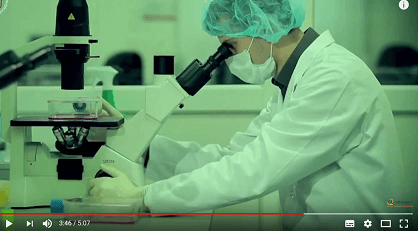What are the differences between fetal stem cells and cultured embryonic stem cells?
Fetal stem cells
Fetal stem cells and fetal tissues dangers
( p source: NIH Revitalization Act )
Human fetal tissue comes from aborted fetuses. A human embryo becomes a fetus nine weeks after conception (the 11th week of pregnancy). For scientific purposes, human fetal tissue or organs can be acquired from either a miscarriage (which is called a spontaneous abortion), an ectopic pregnancy, or an induced abortion. But according to a Congressional Research Service reporton fetal tissue, fetal tissue from induced abortions is preferred for medical research. Spontaneous abortions and ectopic pregnancies are often unpredictable and can pose serious health risks to a woman, so “fetal tissue collected under these circumstances is often not suitable for research purposes.”
Researchers get fetal tissue from several places: abortion providers, tissue banks, or a company supplier. Some researchers acquire fetal tissue from “abortion clinics at their own institutions, or from tissue banks maintained by some universities,” reports the New York Times, and “[m]any buy the tissue from companies that act as middlemen.” Despite what the controversy generated by the videos suggests, Nature reports that only a “handful of [Planned Parenthood] clinics in two states supply fetal tissue for research,” and the Times reports that abortion providers are paid “small fees” — which providers say are reimbursement costs —for fetal tissue specimens. In response to the controversy, however, Planned Parenthood stopped seeking reimbursement for fetal tissue in the few offices where it was collected.
The companies that process the tissue then sell it to researchers for higher prices, sometimes charging up to thousands of dollars for a vial. But even this is not illegal. The founder of one major fetal tissue supplier told the Times that the increased prices reflect the high costs associated with extracting cells or tissue, storing them, and shipping them. StemExpress founder Cate Dyer said that isolating certain fetal cells can “take millions of dollars of equipment” and can cost “thousands of dollars” without a guarantee that it will work. However, the Times also notes that the suppliers “exist in a gray zone, legally,” as “[f]ederal law says they cannot profit from the tissue itself, but the law does not specify how much they can charge for processing and shipping.”
There are numerous restrictions on federal funding of human fetal tissue used in research. After abortion was legalized in 1973, there was a national debate on the ethics of fetal tissue donation and use in research. The government appointed a committee to assess the ethics of collecting and donating fetal tissue, which led to regulations that said that patients cannot be offered money or compensation to undergo an abortion and ensured that researchers “will have no part in any decisions as to the timing, method, or procedures used to terminate a pregnancy.”
In 1993, President Bill Clinton signed the NIH Revitalization Act into law, which also made it illegal to profit from the sale, purchase, or transfer of human fetal tissue used for transplants. The law does, however, allow for reasonable payments for the reimbursement of costs associated with the “transportation, implantation, processing, preservation, quality control, or storage of human fetal tissue.”
The law also requires that a woman consent to an abortion before she can be asked about fetal tissue donation, and she has no say in how the tissue will be used once donated. While Clinton’s regulations apply only to federally funded fetal tissue transplant research, Charo explained that “most clinics and most researchers try to follow the same federal rule, even when it is not required, because it has kind of become a standardized practice.”
The anti-abortion debate has stalled fetal tissue research before. After Roe v. Wage legalized abortion in 1973, the Guttmacher Policy Reportnotes, “antiabortion leaders in Congress seized on fetal tissue research as a weapon in the war against abortion.” The debate led to a temporary moratorium on federal funding of fetal tissue research until a bioethics committee laid out some ethical guidelines about fetal tissue used in federally funded research. The moratorium was lifted in 1975 and the use of fetal tissue in the research community flourished until 1988, when the Reagan administration put a moratorium on all federal funding of fetal tissue transplant research.
A bipartisan ethics commission was again set up to decide on the ethics of fetal tissue transplantation. This commission concluded that using fetal tissue from aborted human fetuses was ethical. However, Reagan went against the commission’s recommendations and continued the moratorium.
Private funding continued and so the work went on, it just went on more slowly in USA, and went on, of course, in other countries ( in Ukrainian NBS stem cell clinic- Editor)
President Clinton signed an executive order lifting the moratorium in 1993.
The current attacks on fetal tissue research pose a serious threat to medical breakthroughs around the world. Many researchers are seeing a steep drop in fetal tissue supply, have suspended their research entirely, or, as in the case of Brigham and Women’s Hospital in Boston, “no longer accepts applications from researchers seeking fetal tissue from abortions performed there,” reports the New York Times.
ETHICAL ALTERNATIVE:
EMBRYONIC STEM CELLS
Embryonic stem cells can become all cell types of the body because they are pluripotent.
Culturing human embryonic stem cells (hESCs) requires a significant commitment of time and resources. It takes weeks to establish a culture, high quality and expensive equipment and reagents, GMP certified biotechnology laboratory and medical facilities, and the cultures require daily attention to multiply until treatment dosage (50, 100, 150 mln / course etc.) .
Once hESC cultures are established, they can, with skill and the methods described, be kept in continuous culture for many years.
Human embryonic stem (hES) cells must be monitored and cared for in order to maintain healthy, undifferentiated cultures.

